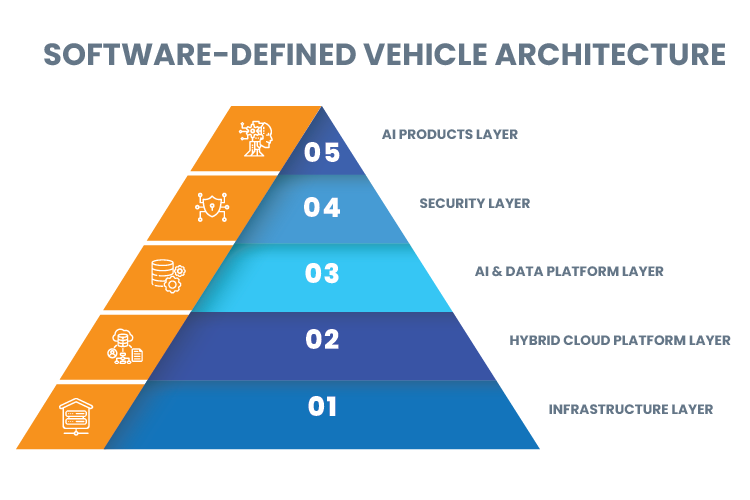
ACL Digital
Software-Defined Vehicles - The Evolution of Automotive Industry
Consumers are showing a growing preference for modern vehicles that offer a digital experience comparable to smart devices. They desire full integration into their digital lives, seeking vehicles capable of managing operations, adding functionalities, and introducing new features primarily or entirely through software updates. This trend reflects a growing preference for digitally integrated automotive solutions that cater to evolving consumer needs and expectations.
Software-defined vehicle refers to any vehicle that primarily or entirely manages its operations, incorporates new functionalities, and enables additional features through software. It serves as the cornerstone of technological advancements in the automotive industry, offering vehicles the capability to evolve throughout their lifespan. This evolution includes benefits such as improved navigation and connectivity, real-time application upgrades, enhanced safety features, and increased sustainability measures. The adoption of SDV technology facilitates the way for transformative developments that enhance the overall driving experience and align with evolving industry standards.
The global software-defined vehicle (SDV) market is expected to experience a significant growth rate, with a projected CAGR of 22.1% from 2023 to 2032, according to a GMI report. This growth is attributed to rising demand for advanced vehicle features, strict safety regulations, increased R&D investments, and improved navigation and connectivity technologies.
Software-Defined Vehicle Architecture
The Software-Defined Vehicles (SDVs) architecture comprises diverse components and systems that empower vehicles to operate and evolve using software. This architectural design is tailored to accommodate the advanced capabilities and flexibility demanded by modern automotive technologies. The following are the dynamic layers within this framework:
Infrastructure layer
In addition to the vehicle, this layer also consists of numerous OEM backend systems, roadside devices, telco equipment, and other such components. All these components contribute to a process where vehicle data serves purposes of development, operation, and services. Insights gleaned from this data drive the delivery of new software to vehicles through over-the-air updates.
Hybrid cloud platform layer
In this setup, a uniform platform spans from the vehicle to the edge of the backend system. This platform is backed by a container orchestration system, enabling software to be distributed flexibly using software containers. This allows developers to create and test software in the backend environment before effortlessly deploying it in vehicles or infrastructure. This approach offers unmatched flexibility in software deployment and management. Abstracting application software into containers for standardization enhances software maintainability and portability, thereby boosting developer productivity. Adopting a hybrid cloud approach empowers OEMs to independently scale and manage edge solutions, optimizing runtimes for efficient in-vehicle use.
AI and data platform layer
Vehicle functionalities like ADAS/AD, and AI models have long played an important role. Some OEMs leverage Artificial intelligence for knowledge management to enhance vehicle safety and personalization. AI plays a vital role in vehicle operations, enhancing cybersecurity by analyzing security events and telematics data for driving insights. Generative AI is now pivotal in SDV development, automating test cases, architecture models, and code creation. This requires robust AI platforms managing optimized models, developing custom ones, and securing engineering data from competitors. AI APIs enable OEMs to deploy and use AI models efficiently in edge devices like vehicles.
Security layer
Automotive manufacturers (OEMs) are adopting a zero-trust cybersecurity framework to address external and internal threats across development, in-vehicle operations, and enterprise environments. A key pillar of vehicle security lies in the Vehicle Security Operation Center, enabling effective implementation of threat detection, security orchestration, QA automation, and response measures. OEMs prioritize message encryption within vehicles and all external communications, while comprehensive security testing for automotive systems is supported by specific testing offerings.
AI products layer
The automotive industry benefits from a modern development platform that facilitates agile software development within a contemporary CI/CD environment. This platform supports traceable requirements engineering, model-based system engineering, and testing, promoting collaboration, managing product complexity, utilizing data-driven insights, and ensuring compliance with regulations. Additionally, AI engineering enables the creation of personalized customer experiences. Customers are assisted in managing the vast data necessary for autonomous driving development through Engineering Data Management solutions. Network Automation intelligent platforms automate and orchestrate network operations in the infrastructure. Connected Vehicle Insight on the backend helps manufacturers develop their connected vehicle use cases.
Why are Software-Defined Vehicles becoming increasingly important?
Software-defined vehicles are a crucial segment of the automotive industry that heavily relies on software to control and optimize various aspects of their operation. The growing significance of these vehicles in the automotive industry can be attributed to several factors, including:
The growing complexity of modern vehicles
Modern automobiles feature advanced technologies like sensors, cameras, and ADAS, with software managing data integration and lifecycle upgrades. This shift towards software-defined vehicles addresses the increasing complexities in modern automotive systems.
Growing demand for customization
As consumer demand shifts towards personalized vehicles, software-defined vehicles offer the flexibility for users to customize their automobiles according to their preferences. For example, features like heated seating can be activated when needed through a subscription service, maximizing value by keeping the solution dormant until necessary, thus enhancing the owner’s return on investment.
The case for greater connectivity
Software-defined vehicles integrate IoT solutions and connectivity to achieve seamless device and network integration, ensuring an optimal user experience. With accessible cloud and Edge computing, computing tasks can dynamically shift between vehicle computers and offboard infrastructure, enhancing real-time data capture and processing.IoT solutions are integral to software-defined vehicles, utilizing Internet of Things technology and connectivity for seamless device and network integration, guaranteeing an optimal user experience.
Emergence and expansion of autonomous driving
Software plays a crucial role in controlling the operation of self-driving cars, making software-defined vehicles essential for the advancement of autonomous driving technology due to their reliance on software for safe and effective navigation.
What are the key benefits of SDV?
SDVs stand out from traditional vehicles due to their advanced intelligence, capable of real-time data processing on a massive scale, leading to more precise and efficient driving decisions.
Increased safety
Equipped with advanced sensors and cameras, SDVs can swiftly detect road obstacles and hazards, responding with greater speed and accuracy than human drivers, thereby substantially decreasing accidents caused by human error and enhancing road safety for all.
Improved fuel efficiency
With their reliance on advanced software and technology, SDVs can adjust driving patterns to minimize fuel consumption, leading to decreased emissions and reduced carbon footprint.
Convenience and comfort
By automating driving tasks, SDVs enable drivers to relax or engage in other activities during their traveling, enhancing travel enjoyment and reducing stress. This newfound freedom also extends benefits to individuals who cannot drive, such as the elderly or disabled, granting them greater mobility and independence.
Software-Defined Vehicles hold great importance due to their significant advancements in transportation technology. As technological progress marches forward, SDVs are anticipated to gain broader acceptance, opening avenues for innovation and revolutionizing our perspectives on transportation.
For the latest updates or additional information, feel free to reach out to ACL Digital. Drop us a message at business@acldigital.com.
Related Insights

ACL Digital Explores How AI is Changing the Game in Clinical Trial Payments and Operations

Transforming Patient Engagement with Cloud-Based AI Chatbots: A Scalable Healthcare Strategy

Testing Strategies & Tools of Mobile App Accessibility Testing

Cloud-Integrated Robotics: Advancing Automation in Manufacturing

Revolutionizing Medical & Pharmaceutical Logistics with IoT




